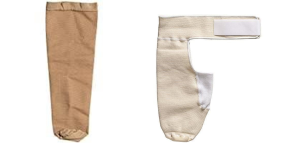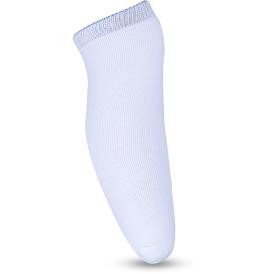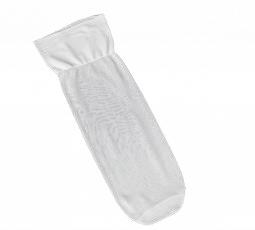What are the types of sock?
During your rehabilitation you will come across several different types of socks and each does a different job. Not all socks are suitable for you. Please use the socks provided for you by your prosthetist.
Compression/Juzo Sock

To reduce swelling in your stump and help create a more cone like/cylindrical shape to your stump so it fits in a prosthesis better.
Put on your sock as you have been shown by your Therapist. Gently place the sock over your limb and pull it up so it is smooth and without wrinkles. Ensure your limb goes right to the end of the sock. If you are an above knee amputee, make sure the sock seam runs up the front of your leg.
Do:
- Wear your sock all day when you are not wearing a prosthesis
- Remove your sock at least once a day to wash your residual limb
- Check the skin for any redness, abrasions or soreness and, if you find any, please leave off your sock until you have had further advice
- Keep the sock well pulled up making sure there are no wrinkles
- Check that the top of the sock does not roll down
- Remove the sock if you feel any pins and needles or pain and contact us
Don’t:
- Wear your sock in bed unless you are advised to do so. Wear your sock with your prosthesis.
Terry knit Sock (thick)

Help maintain a good fit in the prosthesis so that you do not move in the pelite liner and cause skin friction.
Plain Knit Sock (thin)
Like the Terry knit sock but thinner and can be used in addition to Terry knit socks to maintain a good fit in the pelite liner and prosthesis.
Gel Sock

Gel socks are used as part liner, part sock. They are used to maintain a good fit in the pelite liner and prosthesis; as well as the added benefit of reducing friction on the skin of your residual limb. They can be useful if your residual limb remains very sensitive to touch, had pronounced bony prominces, or skin is at risk of breaking
down easily, as they can help reduce the pressure on the skin.
Gel/ Silicon Liner
![]()
When used properly they provide a cushioning effect with the socket, Help to stop friction between the skin and the socket and provide even pressure within the socket. They can be used with Terry and Plain knit socks on top.
Nylon sheath

The thin nylon sock is used to help slide your residual limb into your liner/socket and to help stop friction on your residual limb. It sits over the pelite liner of your prosthesis.
How do I care for my socks?
- Wash your compression sock regularly, by hand or in a 30 or 40 degree washing cycle If the sock loses shape or becomes baggy, stretching it lengthways can improve the shape
- Do not tumble dry your compression (brown) sock or nylon sheath
- Compression/Juzo socks should be dried flat on a towel rather than hung on a line
- You will be given a set of white socks to take home to allow you to wear a clean sock, while you wash any dirty or soiled socks
- In hot weather you may need to change them during the day
- Wash your terry and plain knit socks on a 50 degree wash
- You can tumble dry the white plain knit socks but not the terry knit
- Gel/silicon Liners and Gel Socks should be wiped clean every night with warm, mild soapy water and a cloth. You can also use mild baby wipes to clean the inside surface but ensure that they are cleaned with soapy water once a week if you use baby wipes regularly.
- Ensure they are fully dry putting on
- You may need to take the liner off to be cleaned and dried again in hot weather, as they can make your skin sweat
- Nylon sheaths can be machine washed at 30-40 degrees and then air dried, if perished then they can be replaced at the limb fitting centre
Any Issues?
If you are ever unsure which socks to use, or if you need new socks, please speak with your prosthetist or the rehab team.
